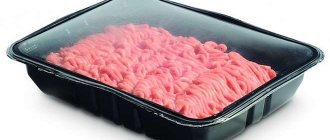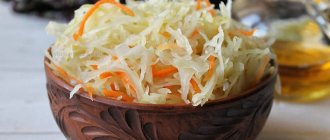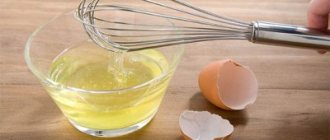The shelf life of buckwheat is limited and does not exceed 2 years for high-quality cereals, which are kept in accordance with the conditions recommended by GOST. At home, dry cereals are often kept longer, but this is wrong - after a year the concentration of useful compounds in them drops. Also, how long buckwheat is stored depends on its type - the kernel lasts longer than the green or processed one. The shelf life of the finished dish is short, up to 1 week in the refrigerator without signs of product spoilage. The exact period depends on other ingredients. You can extend the freshness of cooked buckwheat by freezing the porridge.
How to choose quality cereals
Before you figure out how to store buckwheat, you need to choose it correctly. When choosing cereal in a store, you are faced with several varieties:
- Yadritsa - grains in the form of pyramids. Used for cooking for half an hour.
- Prodel - crushed kernels, cooks faster, 15-20 minutes is enough.
- Green – unprocessed buckwheat, can be steamed with boiling water and sprouted.
- Flakes, Smolensk - highly crushed, does not require cooking, steamed with boiling water or hot milk.
- Flour is ground grain used for baking and making drinks.
In the store, pay attention to the following nuances:
- Choose cereals without debris, husk residues, pebbles, bugs and other insects. All this is visible through the transparent packaging.
- The grains must be the same size. Otherwise, it will not be possible to cook crumbly porridge: part of it will be ready, while the other will remain raw.
- Give preference to cereals packaged in hermetically sealed bags. Weighed products are more quickly affected by pests.
- The dark color of buckwheat indicates that it has been fried. This means that some of the beneficial substances have already been lost.
- It is advisable to choose a product of the highest and first grade. It is not treated with pesticides during cultivation, so it can be safely given to children.
Do you know that…
According to GOST, buckwheat does not have the “Extra” grade, etc. These are inventions of unscrupulous producers. There is the highest, first, second and third. But the product has no varieties at all.
Varieties of buckwheat
A few words about the value of the product
The only people who should not eat buckwheat are allergy sufferers. But for people who have problems with cholesterol in the blood, cereal is very useful. After all, it improves immunity and has many beneficial qualities.
In addition, buckwheat is valued for its high iron content, which is known to affect the saturation of cells with oxygen. In addition, porridge is rich in PP vitamins, which strengthen the nervous system and counteract thrombosis.
So, in Greek there are:
- phosphorus;
- potassium;
- copper;
- calcium and zinc.
Slow-acting buckwheat carbohydrates are useful for people suffering from high blood sugar levels, because... when split, they do not cause sudden spikes in insulin. Meanwhile, buckwheat also contains a lot of protein, which is less toxic and more accessible to the body than animal protein.
However, you should know that the less you cook buckwheat porridge, the more vitamins it will retain. It is also not recommended to cook it with the addition of milk, honey and sugar. But vegetables and fruits can be added to it.
Storing buckwheat
The older generation, having experienced the hardships of life, is unlikely to get rid of the habit of storing food for future use. Many people think that buckwheat is stored for a long time, so in order to avoid another price increase, they buy more of it. But that's not true. The shelf life of buckwheat, like other cereals, is limited.
In a closed package
Conventionally, buckwheat is stored for 2 years. Each variety of buckwheat product has its own shelf life:
- core – 15 months for the Far East, North Caucasus, Lower Volga region and 20 months for other regions;
- completed - 14 and 18 months, respectively.
Buckwheat retains its beneficial properties throughout its shelf life in full, provided:
- hermetically sealed packaging;
- dark, dry room;
- humidity not exceeding 70%;
- air temperature 25 degrees.
The expiration date of buckwheat can be found from the product labeling on the package. In addition, the manufacturer indicates the year and month the product was packaged. When making a purchase, check this information. The date stamped on the affixed label should alert you. After all, it is not known in what conditions the cereal was stored, and how much time passed before it was packaged.
Note to the hostess
When storing cereals beyond their expiration date, it is recommended to take a sample of porridge cooked from it at least once a month, thereby determining the possibility of its further use.
Buckwheat grains contain 18 essential amino acids, and the concentration of microelements and vitamins is almost 3 times higher than in other grains
In open packaging and by weight
After opening the original packaging, the shelf life of the cereal is reduced several times:
- kernel – 4 months;
- completed - 3 months;
- green – 2 months.
Now it is impossible to make claims to the manufacturer about the spoilage of buckwheat. All responsibility for the safety of the product lies with the consumer.
How to store buckwheat at home:
- Remove the cereal from the store packaging and place it in glass, plastic, or metal containers intended for bulk products.
- To extend shelf life, dry the product in the oven or in a frying pan for 8-10 minutes at moderate temperature. Be careful not to overcook the grain, otherwise the nutrients will be destroyed. You can also use the freezer for processing, placing buckwheat there for a day.
- You can remove excess moisture from a container with cereal using kitchen salt. To do this, tie the salt in a piece of gauze and place it at the bottom of the jar.
- Slices of unpeeled garlic and 2-3 bay leaves will help repel insects. Dried lemon peel and chestnut fruits have the same properties. Just stuff them into the buckwheat container.
- There is another trick used to store grain at home. These are linen bags that need to be boiled in a saturated salt solution. Bugs do not grow in such bags, and the contents remain dry.
- It is recommended to find a dry place for containers with buckwheat, away from objects and products that emit strong odors. Otherwise, the cereal will absorb the aromas, and you will have to eat porridge that tastes like coffee, spices, or gasoline.
- There are no restrictions related to lighting in regulatory documents. But we must remember that direct sunlight not only illuminates, but also increases the temperature. The sun should be avoided.
Buckwheat must be present in the diet of diabetics, athletes, pregnant women, vegetarians and dieters
We answer the question: is it possible to store buckwheat on the balcony in winter?
It is not advisable to store buckwheat on the balcony for the following reasons:
- temperature difference;
- humidity changes depending on the weather;
- sunlight has a negative effect.
Pearl barley porridge with turkey and vegetables for the winter
This porridge, canned for the winter, can be used as a complete second course. The product can be reheated or eaten cold. In addition, it can be used to prepare pickle soup, since the composition includes pickled cucumbers. The recipe uses turkey fillet, but you can use any meat that is not too fatty.
- turkey thigh fillet - 300 g;
- pearl barley - 200 g;
- pickled cucumbers - 200 g;
- carrots - 1 pc.;
- onion - 1 large;
- tomato paste - 2 tbsp. l.;
- vegetable oil for frying.
Rinse the cereal and soak for at least 2 hours. Cut the meat into cubes. Grate the carrots and pickles on a coarse grater, chop the onion.
Pour oil into a thick-bottomed pan and fry the meat. As soon as a crust begins to form, add the vegetables, stir and fry everything together for 10 minutes. Then add the cereal and pour in water so that the liquid level is 2 cm higher than the food level. Add salt and spices. As soon as the liquid boils, reduce the heat to low and simmer for 1 hour.
Pack the hot porridge into sterilized jars and cover with boiled lids. Place in a sterilizer (in a pan with a towel on the bottom), pour warm water up to the hangers of the jars. Put on fire. Sterilize from the moment of boiling for 30 minutes. Roll up. Cool and store in the refrigerator.
The same version of canned food can be prepared without adding cucumbers and tomato paste, only with meat, cereals and vegetables.
Signs of spoiled cereal
The quality of buckwheat is determined by examining several spoons of cereal. Pay attention to:
- color - the grains are covered with a whitish coating or mold;
- smell - mustiness and rancidity appear due to outdated fat;
- taste – buckwheat is bitter if you chew 1-2 grains;
- the cereal falls off, forming lumps;
- living creatures appear - bugs, worms, moths.
These signs indicate that the product is not suitable for food. It should be thrown away.
Tip of the day
To check the quality of grain, use this method: grind a spoonful of buckwheat and heat it in a water bath. An unpleasant odor will manifest itself.
If the tests are passed and nothing suspicious is found, it makes sense to cook a portion of porridge and try it.
Canned buckwheat porridge with beef, cooked in the oven
It is convenient to prepare homemade canned food in the oven. The preparation turns out aromatic and very tasty.
- beef pulp cleared of films and fat - 2 kg;
- buckwheat - 1 kg;
- onion - 2 pcs.;
- lard or vegetable oil - 2 tbsp. l. on the jar;
- salt, allspice and black pepper, bay leaf, cloves - to taste.
From the specified number of components, approximately 10 1-liter cans of canned food are obtained.
Place 1 clove inflorescence, 3 laurel leaves, and 5 peppercorns into clean jars. Cut the meat into pieces and fill the jars with them to a third of the volume. Pour washed buckwheat on top so that half the volume is occupied.
Pour hot water into the jars to fill 2/3 of the volume, add salt (1 teaspoon at a time) and pour in oil or add lard. Cover the jars with foil lids. Place in a cold oven and set the heat level to 150 degrees.
As soon as the liquid boils, reduce the heat level to 120 degrees and keep the jars in the oven for 4 hours. Then immediately roll up the jars and leave to cool in the air.
- beef pulp cleared of films and fat - 2 kg;
- buckwheat - 1 kg;
- onion - 2 pcs.;
- lard or vegetable oil - 2 tbsp. l. on the jar;
- salt, allspice and black pepper, bay leaf, cloves - to taste.
At room temperature
Boiled cereal in a warm place - in the kitchen or in the room - is stored for no more than 4-5 hours at a temperature of 18 to 22 degrees. At room temperature from + 24 degrees and above, it should be consumed no later than two to three hours from the moment it has completely cooled. Accordingly, the higher the thermometer readings and the higher the humidity, the faster the product will spoil.
The above applies to “empty” porridge. But seasoned with milk or butter, buckwheat can be stored even less. The dish will spoil in the heat in just one and a half to two hours.
In addition to room conditions and a refrigerator, there is another option for storing boiled cereals: a loggia or balcony. However, cooked cereals can only be stored in this place in autumn, winter and early spring, at low temperatures. The indicators should be close to those displayed in the refrigerator. But even if the buckwheat porridge freezes over the winter night, it’s not scary. Nothing will happen to fresh porridge. Simply reheat and the product is ready for use again.
Storing boiled buckwheat
The kernels are used to make a delicious crumbly porridge, which also needs to be properly preserved. Lack of time forces many housewives to prepare food with a supply of several days. You need to figure out how long boiled buckwheat can be stored.
Cooked porridge on the stove will spoil within 24 hours. This is clear from the following signs:
- a sour smell appears;
- mucus forms at the bottom of the pan;
- the surface becomes moldy.
There are several ways to preserve boiled buckwheat:
- placing in the refrigerator;
- placing it on a cold balcony or loggia;
- frozen in the freezer.
Buckwheat goes well with dry and fresh fruits, vegetables, mushrooms, nuts, meat and milk. Just not with sugar, which neutralizes all its beneficial properties.
In the refrigerator, the finished product retains its benefits for no more than 3 days. At the same time, oil, vegetables, and meat are not added to the porridge. Observe the following conditions:
- Cover the container with porridge with a lid and place it on the refrigerator shelf.
- Maintain the temperature no higher than 4 degrees Celsius.
- Reheat, reserving desired portion.
If it is winter outside, then the pan can be taken out to the balcony or loggia. There the porridge will stand painlessly for 3 days at a temperature of 4 degrees, and at minus for a week.
Note to the hostess
You need to make sure that the sun does not fall on the container with porridge. This causes the pan to heat up, causing the product to spoil faster.
Cooking rabbit stew with rice in a slow cooker
It’s very easy to prepare porridge in a multicooker; just add the ingredients according to the norm and turn on the desired mode. No more attention required. To prepare this version of the workpiece, as a rule, a rabbit carcass, cut into pieces, is used. You can also use fillet.
- rabbit - 850 g;
- unsalted pork lard - 50 g;
- vegetable oil - 30 ml;
- Short grain rice - 500 g;
- bay leaf - 1 pc.;
- salt, black pepper to taste.
Rinse the carcass, disassemble into pieces, and dry. The pieces should be large enough, but they should fit freely into the jar.
Pour vegetable oil into the bowl and turn on the “fry” mode. After 5-7 minutes, when the oil is hot, add the meat and fry. The meat should be warmed through and slightly browned.
Cut the lard into thin slices and add to the rabbit meat. Add spices and salt. Add washed rice and pour hot water. You need to take twice as much water as rice.
Turn on the “quenching” mode for 4 hours, then leave for another 1 hour on the “heating” mode. Place the hot stew into sterilized jars and roll up immediately. Allow the jars to cool and store strictly in the refrigerator.
Homemade canned porridge with meat is a complete dish that will help out in a situation where you don’t have time to cook; you just need to heat it up. You can use canned food to make soup or as a pie filling. To prepare the preparation, you can use any type of cereal and meat.
Useful tips
Experienced housewives share their recommendations for choosing and storing this product:
- You can store buckwheat for a long time only if the grain is of high quality. It should not contain pebbles, husks, insects, grains should be approximately equal in size. Buy buckwheat in transparent packages - it’s easier to assess the quality of the product
- Keep cereals out of direct sunlight.
- A small bag of salt will help protect the cereal from excess moisture.
- Heat-treat the cereal before placing it in a storage container. 8-10 minutes in the pan will be enough. It is important that buckwheat is not overcooked, otherwise it will lose all its beneficial qualities.
To ensure that cooked buckwheat is crumbly, follow the following algorithm:
- Place the cereal in a saucepan, pour water into it so that it slightly covers the product.
- Place the container over medium heat and wait until the water begins to boil.
- Then reduce the heat, add seasonings and salt to the pan. Cook the buckwheat for about 10-15 minutes.
- Remove the pan and cover it with a thick cloth such as a towel. Leave the dish for 15-30 minutes.











